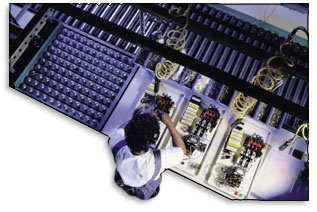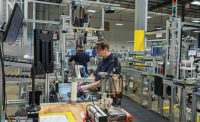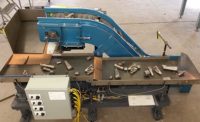
Sometimes, this old-fashioned dose of hocus-pocus shares similar characteristics to parts positioning. After a series of rapid movements, assemblers can't always predict whether the parts they need will show up where, when and how they're supposed to before placement.
New technology, such as machine vision, is taking some of the guesswork out of the parts positioning process. However, getting the right part in the right place at the right time with the right side up continues to baffle manufacturing engineers.
Whether it's a manual or automated process, a part has to be in the right place to be correctly assembled. In a manual process, a part that's difficult to reach will slow down an assembler and raise the risk of ergonomic strain. With automated assembly systems, an incorrectly positioned part can jam equipment, damage other parts and upset production schedules. "Any time a part is positioned correctly, it improves efficiency," says Carl Nelson, president of Performance Feeders Inc. (Oldsmar, FL).
Parts positioning is not just a matter of physical location. It is a combination of singulation, orientation and presentation. Singulation is the process of separating a mass of parts into individual parts. Orientation means to set or arrange a part in a determinate position from random positions. Presentation refers to the process of moving a singulated, oriented part to a predetermined location where a robot, rotary index table or other device can manipulate it.
Singulation, orientation and presentation can be handled within a parts feeder or divided among the feeder and various accessories. Parts can be positioned at the same time they are fed, or positioning can be performed as a separate function.
Parts feeding and parts positioning are separate, but closely connected processes that must work in conjunction to be effective. "Feeding refers more to the funneling and orienting of parts to a specific location," says Gary Hood, application specialist at FMC Corp. (Homer City, PA). "Positioning is the process of actually moving parts into location via a shuttle, robot or other device."
A variety of methods can be used to feed parts, including electromagnetic vibratory feeders, centrifugal feeders, rotary orienting feeders, inline feeders, dual opposing belt feeders and floor elevator feeders. Each has unique advantages and disadvantages for handling particular parts and processing applications.
"Feed rate is the biggest challenge right now," says Dennis Reynolds, applications engineer at Service Engineering Inc. (Greenfield, IN). "Parts can be assembled more quickly than most feeder bowls can feed them. And, a lot of parts still aren't designed to be fed efficiently."
"The challenge is to achieve the correct orientation at the required rate of speed," adds Hood. "And the feed rate keeps going up. Three years ago, the typical assembler would have a machine running at 70 parts per minute; now, they want it to run 90 parts a minute. That's forcing people to move from standard methods to more complex methods to position parts."
Positioning is usually handled sequentially, after parts are sorted and fed, using vibratory or centrifugal bowls. Many automated assembly applications use bowls to feed and orient parts for presentation to the machine that will perform the assembly task. Parts that are not correctly aligned fall back into the bowl and continue through the process until they are correctly aligned. Escapements and similar devices separate individual parts and orient them as they travel around and out of the bowl.
Outside track bowls are typically used for complex part orientation. Cascade bowls are most often used for feeding simple to moderately complex parts because they have a limited tooling area.
According to Hood, speed, flexibility and ease of integration must all be considered. But, the ultimate decision on what method to use depends on part configuration and complexity. Variables such as size, shape, density, concentricity and material will determine how effectively a part can be positioned.
Ultimately, any feeder should complement the orientation requirements of the application. Parts must be presented to the assembly machine in correct orientation. "Parts can be compared in terms of simple, moderately complex and complex," says Hood.
Simple orientation means a part only needs to be oriented longitudinally at random, or on the flat at random. A part that is considered moderately complex in its orientation must be oriented with a hanging attitude, an open side, a standing attitude or a rolling position where the diameter is greater than the length. A part that needs to be oriented with a specific end leading, a rolling position where length is great than diameter, or a part that has tabs, projections, legs, flanges or points, is considered to be complex.
Six Degrees of Separation
The transition from the feeding and positioning system to the assembly system often occurs at the pickup mechanism or cross shuttle located at the end of the feeder. Six basic positioning techniques can deliver oriented parts to the correct location:- Reject and recirculate. One of the simplest and most effective mechanical positioning methods is a system that rejects and recirculates parts that are not correctly oriented. Those parts are then captured and recirculated until they are correctly oriented.
- Raising the part up out of the nest. A nest is a pocket at the end of an inline feeder or track. When it is necessary to pick up a part that is difficult to isolate from other parts, the entire next can be lifted by a pneumatic cylinder. This allows the part to be picked up by a gripper or vacuum head. The nest is then retracted to receive another part and the cycle is repeated.
- Shoving the part to the side for pick up. Parts traveling along an inline feeder can be pushed to one side by a pneumatic cylinder so they can be handled separately. They enter a nest, which is then shuttled to one side of the line. With some parts, such as coil springs, this method may use an optional tube through which the part is blown once it is isolated.
- Releasing single parts into a dead nest section. This method is common with inline feeders. Because the nest has no vibratory action, the part is generally pushed into the nest by the previous part. Isolated from vibration, the part is reasonably stable for pick up by a vacuum head or gripper. This technique works best with parts that have been previously oriented by lips, detents, cams or levers along the track.
- Tucker style. Where there is no room for two cylinders, a single cylinder attached to a slide with a cam achieves a compound motion that simultaneously moves a part up and out. Some preorientation may be needed because this method will not take a jumble or randomly oriented parts and position them correctly. This type of mechanism should not be used on a coil spring or fastener.
- Release and blow. This method can be used when parts are symmetrical or positioning is primarily end-to-end. One part at a time is released and allowed to drop, by gravity, into a delivery tube. Air pressure blows it through the tube into a receiver. The advantages of this method are an increase in speed, caused by the air pressure assist, and positive placement because the tube guides the part into position.
Part Pickup
Several different methods can be used to pick up parts, including mechanical, magnetic and vacuum hands or grippers. If the weight or configuration of a part is suitable, a vacuum head is commonly used. This method is effective for lightweight parts that feature flat surfaces.For uneven part configurations, pneumatically-actuated grippers may be a more reliable pickup method. If a part is cylindrical and picked up vertically, V-shaped grippers may be necessary.
The effect of cumulative tolerances usually determines which pickup mechanism to use. For example, a molded plastic part will have a broader tolerance range than a metal part.
Pick-and-place mechanisms operate in a variety of ways. Some pick vertically, transfer along a straight path horizontally and place vertically. Others pick vertically, transfer around the arc of a circle in a horizontal plane and place vertically.
Speed requirements often limit mechanical handling methods. Alternatives, such as robotic grippers, arms and fingers, can be used to pick up or grasp parts and place them into an assembly station or fixture.
Part size also is influencing more widespread use of robotic equipment. "Parts are getting smaller and smaller," says Larry Freiherr, project manager at Hendricks Engineering Inc. (Indianapolis). "That means we must hold and produce higher tolerances."
Guiding Vision
Advances in machine vision technology have enabled assemblers to dramatically improve the parts positioning process. Faster, cheaper cameras are spurring the application of machine vision systems for parts positioning. In fact, vision is at the heart of flexible assembly systems that can feed and position parts in a wide variety of sizes and shapes."Flexible automation systems that incorporate the latest vision and robotics technology are getting more and more affordable," says FMC's Hood. "We're definitely seeing more demand for vision applications."
Typically, an overhead vision system works in conjunction with a pick-and-place robot to detect the location and orientation of a part, and adjust a robotic arm for correct placement. By using a camera to handle part orientation and selection, bulky mechanical tooling and equipment can be eliminated. The end result is a parts feeding and positioning system with a much smaller footprint than in the past, says Service Engineering's Reynolds.
"Vision systems are faster, more robust and easier to program," says Joe Campbell, vice president of marketing at Adept Technology Inc. (San Jose, CA). "Vision allows feeding and positioning applications that are much more flexible than hard tooling, which take a lot of time to design and build.
"Vision applications for parts positioning started in the electronics industry," adds Campbell. "But, we're starting to see more applications in traditional, durable goods manufacturing, such as appliance and automotive assembly."
Manual Methods
The challenge of positioning parts is not limited to auto-mated assembly applications. Manual assembly processes also demand precise parts positioning to achieve throughput levels.Ergonomic factors, such as the height and location of parts bins, must be taken into account. Parts positioning considerations should aim to reduce the risk of repetitive motion injury. In applications where assemblers are stationed along a table or conveyor and reach into parts bins repetitively, a feeder system that orients parts correctly will ensure that the assembler only needs to lift and place the parts with a straight-line motion.
Correct positioning of support materials, such as parts bins, will improve yields. Bins should be located within each assembler's ergonomic reach zone. The primary reach zone is the area in which a person can comfort-ably work with minimal arm, head or trunk movement. Positioning parts bins in this zone will eliminate wasted movement and improve comfort levels. Parts bin location also depends on whether assemblers sit or stand at a workstation.
- A part isn't good until it's in the right location where it's needed," notes Ralph Frye, director of business development at SpeasTech Inc. (Little Rock, AR). He says anything that can reduce the amount of time it takes an assembler to locate the correct part is critical to boosting productivity.
- Any manual assembly process is a source of potential error," adds Frye. "Even the most conscientious assemblers are prone to mistakes, especially in boring or repetitive jobs. And, when parts look similar, the wrong part can easily be selected."
Positioning Problems
Unfortunately, not all parts are easy to position. Typically, the more features there are to work with on a part, the harder it is to position. "Parts with a lot of features cause more problems than parts with fewer features," says Ryan Walters, director of marketing at Vibromatic Co. (Noblesville, IN).Some parts, such as springs, are a constant source of headaches. In fact, open coil springs with a hook on each end can be a nightmare to position. Unlike other parts, springs tend to tangle and shingle very easily. "Everyone has them in assembly applications," laments Walters. "It's hard to hold springs to a specific tolerance."
Flexible, soft parts, such as rubber key pads on cell phones or surgical sponges, tend to pose positioning problems. Those types of part have no rigid surface to grab a hold of.
Extremely thin parts--anything less than 0.015-inch thick--can also be very difficult to position. "Air current and electrostatic charges can play havoc on tiny parts," warns Jeff Kopel, applications engineer at Deprag Inc. (Lewisville, TX).
On the other hand, a part such as a cap is much easier to position. "Usually, there's a 50 percent chance that the top will either be facing up or down," says Walters.
Parts manufactured overseas can also cause positioning problems. If these parts have loosely held tolerances and no consistency, they will be harder to hold and position.


